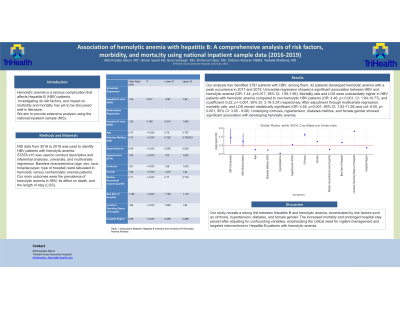Sunday Poster Session
Category: Liver
P1212 - Association of Hemolytic Anemia With Hepatitis B: A Comprehensive Analysis of Risk Factors, Morbidity, and Mortality Using National Inpatient Sample Data (2016-2019)
Sunday, October 27, 2024
3:30 PM - 7:00 PM ET
Location: Exhibit Hall E

Has Audio

Mhd Kutaiba Albuni, MD
Department of Internal Medicine, TriHealth Inc., Cincinnati
Cincinnati, OH
Presenting Author(s)
Mhd Kutaiba Albuni, MD1, Bisher Sawaf, MD2, Bana Sabbagh, MD3, Mohamad Hijazi, MD4, Shahem Abbarah, MD5
1TriHealth, Doha, Ad Dawhah, Qatar; 2University of Toledo, Toledo, OH; 3TriHealth, Cincinnati, OH; 4TriHealth Good Samaritan Hospital, Cincinnati, OH; 5MedStar Health, Baltimore, MD
Introduction: Hemolytic anemia is a serious complication that affects Hepatitis B (HBV) patients. Investigating its risk factors, and impact on morbidity and mortality has yet to be discussed well in literature. We aim to provide extensive analysis using the national inpatient sample (NIS).
Methods: NIS data from 2016 to 2019 was used to identify HBV patients with hemolytic anemia. STATA x15 was used to conduct descriptive and inferential analyses, univariate, and multivariate regression. Baseline characteristics (age, sex, race, hospital payer, type of hospital) were tabulated in hemolytic versus nonhemolytic anemia patients. Our main outcomes were the prevalence of hemolytic anemia in HBV, its effect on death, and the length of stay (LOS).
Results: Our analysis has identified 3797 patients with HBV; among them, 42 patients developed hemolytic anemia with a peak occurrence in 2017 and 2019. Univariate regression showed a significant association between HBV and hemolytic anemia (OR: 1.44, p=0.017, 95% CI: 1.06-1.96). Mortality rate and LOS were substantially higher in HBV patients with hemolytic anemia compared to non-hemolytic HBV patients (OR: 4.46, p< 0.001, CI: 1.84-10.77), and (coefficient: 6.22, p< 0.001, 95% CI: 3.19-3.24) respectively. After adjustment through multivariate regression, mortality rate, and LOS remain statistically significant (OR: 4.55, p=0.001, 95% CI: 1.83-11.28) and cof: 6.05, p< 0.001, 95% CI: 3.05 - 9.06). Underlying cirrhosis, hypertension, diabetes mellitus, and female gender showed significant association with developing hemolytic anemia.
:
Discussion: Our study reveals a strong link between Hepatitis B and hemolytic anemia, accentuated by risk factors such as cirrhosis, hypertension, diabetes, and female gender. The increased mortality and prolonged hospital stay persist after adjusting for confounding variables, emphasizing the critical need for vigilant management and targeted interventions in Hepatitis B patients with hemolytic anemia.
Note: The table for this abstract can be viewed in the ePoster Gallery section of the ACG 2024 ePoster Site or in The American Journal of Gastroenterology's abstract supplement issue, both of which will be available starting October 27, 2024.
Disclosures:
Mhd Kutaiba Albuni, MD1, Bisher Sawaf, MD2, Bana Sabbagh, MD3, Mohamad Hijazi, MD4, Shahem Abbarah, MD5. P1212 - Association of Hemolytic Anemia With Hepatitis B: A Comprehensive Analysis of Risk Factors, Morbidity, and Mortality Using National Inpatient Sample Data (2016-2019), ACG 2024 Annual Scientific Meeting Abstracts. Philadelphia, PA: American College of Gastroenterology.
1TriHealth, Doha, Ad Dawhah, Qatar; 2University of Toledo, Toledo, OH; 3TriHealth, Cincinnati, OH; 4TriHealth Good Samaritan Hospital, Cincinnati, OH; 5MedStar Health, Baltimore, MD
Introduction: Hemolytic anemia is a serious complication that affects Hepatitis B (HBV) patients. Investigating its risk factors, and impact on morbidity and mortality has yet to be discussed well in literature. We aim to provide extensive analysis using the national inpatient sample (NIS).
Methods: NIS data from 2016 to 2019 was used to identify HBV patients with hemolytic anemia. STATA x15 was used to conduct descriptive and inferential analyses, univariate, and multivariate regression. Baseline characteristics (age, sex, race, hospital payer, type of hospital) were tabulated in hemolytic versus nonhemolytic anemia patients. Our main outcomes were the prevalence of hemolytic anemia in HBV, its effect on death, and the length of stay (LOS).
Results: Our analysis has identified 3797 patients with HBV; among them, 42 patients developed hemolytic anemia with a peak occurrence in 2017 and 2019. Univariate regression showed a significant association between HBV and hemolytic anemia (OR: 1.44, p=0.017, 95% CI: 1.06-1.96). Mortality rate and LOS were substantially higher in HBV patients with hemolytic anemia compared to non-hemolytic HBV patients (OR: 4.46, p< 0.001, CI: 1.84-10.77), and (coefficient: 6.22, p< 0.001, 95% CI: 3.19-3.24) respectively. After adjustment through multivariate regression, mortality rate, and LOS remain statistically significant (OR: 4.55, p=0.001, 95% CI: 1.83-11.28) and cof: 6.05, p< 0.001, 95% CI: 3.05 - 9.06). Underlying cirrhosis, hypertension, diabetes mellitus, and female gender showed significant association with developing hemolytic anemia.
:
Discussion: Our study reveals a strong link between Hepatitis B and hemolytic anemia, accentuated by risk factors such as cirrhosis, hypertension, diabetes, and female gender. The increased mortality and prolonged hospital stay persist after adjusting for confounding variables, emphasizing the critical need for vigilant management and targeted interventions in Hepatitis B patients with hemolytic anemia.
Note: The table for this abstract can be viewed in the ePoster Gallery section of the ACG 2024 ePoster Site or in The American Journal of Gastroenterology's abstract supplement issue, both of which will be available starting October 27, 2024.
Disclosures:
Mhd Kutaiba Albuni indicated no relevant financial relationships.
Bisher Sawaf indicated no relevant financial relationships.
Bana Sabbagh indicated no relevant financial relationships.
Mohamad Hijazi indicated no relevant financial relationships.
Shahem Abbarah indicated no relevant financial relationships.
Mhd Kutaiba Albuni, MD1, Bisher Sawaf, MD2, Bana Sabbagh, MD3, Mohamad Hijazi, MD4, Shahem Abbarah, MD5. P1212 - Association of Hemolytic Anemia With Hepatitis B: A Comprehensive Analysis of Risk Factors, Morbidity, and Mortality Using National Inpatient Sample Data (2016-2019), ACG 2024 Annual Scientific Meeting Abstracts. Philadelphia, PA: American College of Gastroenterology.
